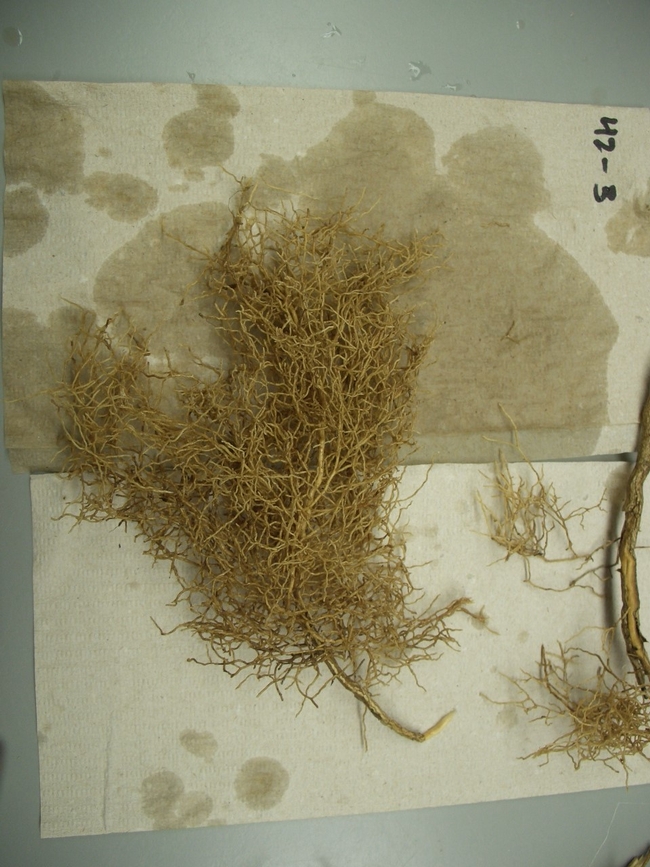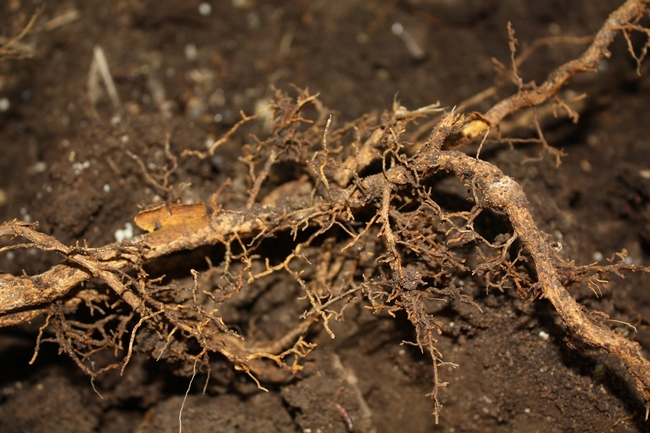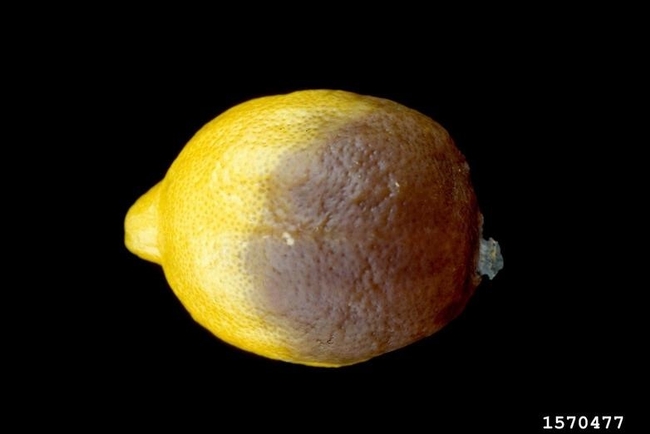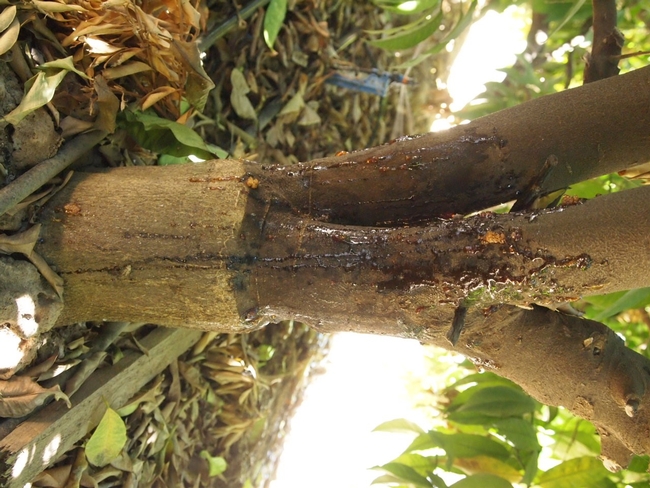There are at least four species of Phytophthora species (P. citrophthora, P. parasitica, P. syringae, and P. hibernalis) associated with citrus in California and all species can cause various symptoms in citrus including the three main ‘diseases' associated with Phytophthora spp. The three diseases in citrus caused by these fungal-like pathogens are; Phytophthora Root Rot, Phytophthora Brown Rot of citrus fruits both pre-and post-harvest, and Phytophthora gummosis, which causes a canker at the lower area of the tree usually at or around the soil line. These organisms are active within the field essentially all year long so one tree could possibly have all three disease symptoms at one time but this is usually not the situation. These pathogens are also ubiquitous within the soils of California citrus groves so keeping an eye out for these diseases is essential to help manage these citrus issues.
Phytophthora Root Rot (PRR): PRR is caused primarily by P. citrophthora and P. parasitica. The former is most active in the winter with respect to PRR whereas the latter is more active in warm weather so PRR can be found throughout the year. This disease can affect young to mature trees and is often associated with groves that do not have good drainage such as high clay soils. For example, in the Terra Bella area of the San Joaquin Valley, there are areas with high clay soils that lead to problems with PRR due to the lack of drainage which can also lead to additional disease issues such as Dry Root Rot (Fusarium solani). In fact, both pathogens seem to work in tandem because Phytophthora can weaken the trees by destruction of the feeder roots leading to colonization by Fusarium solani and both pathogens can often be isolated in these situations.
Both pathogens are common throughout most citrus grove soils and can survive for years in the soil by producing persistent spores (clamydospores). When moisture is present in the soils, these pathogens can then produce oospores which are the reproductive spore stage. Oospores will differentiate into motile swimming zoospores that are released by the oospores and swim in the free water in the soil towards the primarily feeder roots. These motile zoospores are the infective spores which can decimate the citrus root system leading to potential death of the tree.
Trees that are infected with this disease will often show light green to yellowing of the leaves, thinning of the canopy, and often causes a slow decline of the tree once infected (Fig 1). The trees decline because the feeder roots get destroyed so the plant cannot uptake water and nutrients effectively, thus leading to potential death of the tree. If PRR is the potential suspect of decline, it is possible to dig up roots to evaluate them because this pathogen mostly infects the feeder roots below the soil line within a foot or so from the surface of the soil line. Figure 2 shows what a healthy root system looks like as well as a root system infected by the pathogen. The colonization of the feeder roots is primarily within the root cortex which becomes soft and disintegrates these cells which makes it easy to separate this tissue layer from the stele of the feeder root.
Root rot can also lead to other diseases due to stressing the plants once feeder roots are consumed by Phytophthora. For example, Fusarium solani, which causes dry root rot in citrus is a secondary pathogen that usually only infects citrus once the trees are under stress. Moreover, if the citrus trees are already infected with Citrus tristeza virus (CTV), the combination of CTV and F. solani can play a major role in quick decline of citrus on sour orange rootstock. Other viruses or viroids may also play a role in this interaction but no studies that we are aware of have tested this specifically.
Fig 1. Yellowing and thinning of citrus canopy due to Phytophthora infection.
Figure 2. Healthy root system of a citrus plant (top)
and a root system infected with Phytophthora showing decay of the feeder root system (bottom).
Brown Rot: This disease is caused by the various Phytophthora spp. and is usually associated with mature fruits. However, twigs, leaves, and flowers can also occasionally be infected which can result in death of these tissues. This disease is usually associated with cool and wet conditions. The symptoms can be seen in the field, primarily on low lying fruit because the spores of the pathogen can get dispersed with water and wind and move from the soil to the low-lying fruit in the tree (Fig 3). Therefore, it is recommended to ‘skirt' the trees so that there is no low-lying fruit to get infected. Brown rot can also occur after the fruit is picked (not showing symptoms) so it is also a post-harvest issue as well. In this situation, fruit that does not show obvious symptoms may be picked and stored at the packing house and the disease can spread to healthy fruit during storage.
Fig 3. Brown rot symptoms of Phytophthora on a lemon fruit.
Phytophthora Gummosis (PG): This disease is caused by the various Phytophthora spp. This disease is usually only seen around the soil line to a foot or so above the soil line but could produce a larger canker higher up the trunk (Fig 4). The disease is recognizable because once infected, the tree starts to produce compounds to combat the infection which results in oozing of sap from small infected cracks in the bark which may look as if the tree is bleeding. The bark usually remains firm but dries out and eventually cracks and can slough off the trunk. Sometimes a white crust appearance will also be seen within and around the canker. Once an infection occurs and the tree is not treated, the canker can eventually spread around the circumference of the trunk that can lead to complete girdling of the tree. This can weaken the tree leading to general decline and or kill the tree which can occur within a year under favorable conditions (moist and cool) but usually will take several years of active infection to cause major damage.
Figure 4. Gummosis symptoms on lower trunk of a citrus tree. Note that the scion is more susceptible than the rootstock because most growers use Phytophthora tolerant rootstocks.
General information on control of Phytophthora diseases. If a grower has a field that has had a history of various Phytophthora issues, there is the possibility to do a pre-plant fumigation using metam sodium or chloropicrin. If a grove becomes infected after planting, the most common methods of control are the use of chemicals usually applied through the drip lines. The most common products are Aliette, Ridomil Gold, and Prophyt. In the last several years, another product (Orondis), as well as some other chemistries, have been developed to control Phytophthora diseases. In this study, minimum effective rates to reduce Phytophthora root rot incidence and pathogen soil populations were determined after one and two applications in fall 2016 and summer 2017, respectively, and greenhouse studies confirmed the efficacy of the new fungicides. These findings led to fluopicolide recently receiving a federal and oxathiapiprolin (Orandis) a full registration for use on citrus. The researchers also requested that ethaboxam and mandipropamid also be considered for registration for control of Phytophthora diseases of citrus in CA. These new compounds will provide highly effective treatments and resistance management strategies using rotation and fungicide mixtures for the control of Phytophthora root rot of citrus.
Micronutrient sprays that contain phosphite may also help to control these diseases because this molecule stimulates a systemic inducedresistance response in the citrus trees that helps the plant fight off infections. The new compounds will provide good control when used in a rotation to avoid resistance, as has happened with many older products. For additional information regarding these new options for control of Phytophthora root rot of citrus, see. (https://apsjournals.apsnet.org/doi/10.1094/PDIS-07-18-1152-RE).
More details on Phytophthora and its control can be found at the UC IPM website; https://www2.ipm.ucanr.edu/agriculture/citrus/?src=redirect2refresh.




